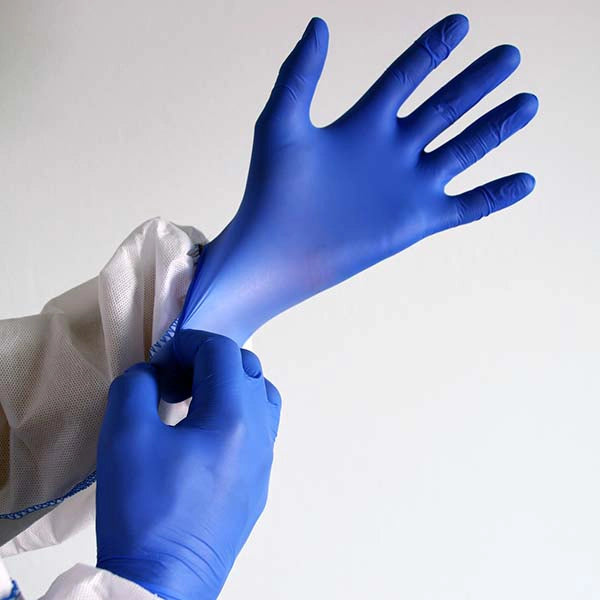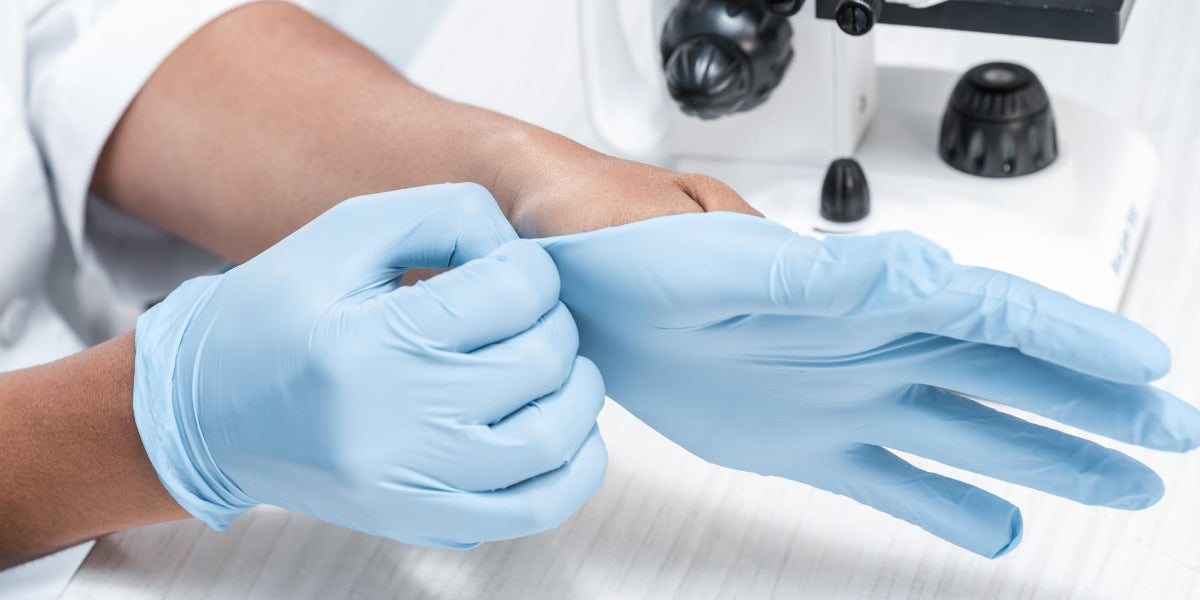Wish you could get extra protection against toxic materials, chemicals, and weather? You can! Learn how in the next few minutes.
Both neoprene gloves and nitrile gloves are great for use in different applications and have numerous benefits. Both glove types offer excellent elasticity which means they will easily return to shape when stretched. Let's explore further which type of protective gloves are right for you.
At a glance:
Neoprene Gloves vs Nitrile Gloves — What’s the Difference?
Here are four differences between neoprene gloves vs nitrile gloves that can help you identify which one fits your needs, preferences, and uses.
Material
When it comes to materials, both neoprene and nitrile gloves are made from synthetic materials. Nitrile gloves are made from acrylonitrile and butadiene, while neoprene gloves are made from polychloroprene rubber.
Protection
Neoprene gloves offer outstanding abrasion resistance and resistance to oils, fats, mild acids, and most solvents. While nitrile gloves offer superior resistance from abrasions, punctures, or cuts. They also protect the wearer from numerous harsh chemicals.
When it comes to natural or environmental effects, neoprene gets the win. Neoprene gloves offer excellent sunlight, ozone, water, and oxidation resistance. They also provide good gas permeability resistance.
Nitrile gloves also provide environmental resistance, just not as excellent as neoprene gloves. They offer excellent water resistance but poor sunlight, oxidation, and ozone resistance.

Characteristics
Neoprene gloves last longer and resist degradation better than nitrile gloves. They are designed to endure and withstand petroleum-based hydraulic fluids and mixtures such as solvents, oils, greases, etc. On the other hand, nitrile gloves are less flexible and don’t contain any latex protein. They are durable but decrease the fingers' dexterity and flexibility.
Use
Nitrile gloves are typically used for chemical handling, agriculture, and oil refining. On the other hand, neoprene gloves are commonly used in oil refineries, printing industries, and industrial chemical processing.
If you handle oil or fuel and are in need of abrasion and temperature-resistant gloves, nitrile gloves are your best bet. Nitrile gloves offer temperature resistance up to 280 degrees F. However, it is important to know that nitrile gloves offer poor flame resistance. If your tasks or work require sunlight, fire, ozone, or weather resistance, skip the nitrile gloves and go for neoprene gloves.
Some neoprene gloves meet flame, smoke, and toxicity requirements (FST). Neoprene gloves are typically used if your task is related to HVAC units, door deals, window seals, electrical or electronic enclosures, weather stripping, and vibration mounts.
Both nitrile and neoprene gloves offer chemical resistance, resistance to abrasion, and are waterproof gloves. However, the type of chemicals, materials, and tasks you handle will dictate your gloves.
Let’s take a closer look at both types of gloves, including their strengths and weaknesses.
What Are Neoprene Gloves?
Neoprene gloves are made from a synthetic, man-made rubber called chloroprene polychloroprene (CPR) or chloroprene rubber. Molecules of this chemical are strung together through a free radical polymerization process using various chemical reactions. Then the material is vulcanized with zinc oxide or magnesium oxide to make it into a more flexible material.
What is Neoprene Rubber?
“Neoprene rubber” is just another word for polychloroprene or neoprene. This material is part of the synthetic rubber family, but many people just call it “neoprene” because it’s different from natural rubber.
Advantages of Neoprene:
- Finger dexterity and good pliability
- High density, impact resistance, high resilience, cut resistant, and resistant to tears
- Superior resistance to degradation from sunlight, weather, oxidation, ozone, aging, freons, and mild acids
- Excellent for use outdoors
- Moderate resistance to petroleum products and oils
- Mostly resistant to fats, greases, and solvents
- Superior protection against many chemicals
- Highly flexible, durable, and elastomeric
- Returns to original shape easily after being stretched
- Warm and waterproof
The biggest advantage of neoprene gloves is the superior resistance to impact and weather.
What Do Neoprene Gloves Protect Against?
Neoprene gloves are used to protect against oils, flames, heat, and many other harmful environmental factors. They also provide protection against abrasion, hydraulic fluids, alcohols, gasoline, akalis, and organic acids.
Is Neoprene a Good Material?
Not all neoprene gloves are made the same. Different manufacturers use different amounts of chloroprene in their neoprene. This means different qualities and characteristics exist for each type of neoprene glove.
What Are Nitrile Gloves?

Nitrile gloves are manufactured from a synthetic rubber called nitrile. It is resistant to chemicals made from acrylonitrile butadiene styrene (ABS) polymers that are formed through a free radical polymerization process. ABS is known for its high chemical stability, good flexibility, good elasticity, low compression set points, and high strength-to-weight ratios.
Advantages of Nitrile:
- High chemical resistance and solvent resistance
- Resistant to engine oils, acids, alkalis, aliphatic hydrocarbon, fuels, and gasoline
- Superior resistance to petroleum-based hydraulic fluids
- Good resistance to abrasion and does not tear easily
- Will not become waterlogged or break down in water
- Highly puncture-resistant
Nitrile gloves are specifically made for use in wet-working environments. They provide the right balance of flexibility, durability, and strength that makes them popular in many industries.
What is Nitrile Rubber?
“Nitrile rubber” is another word for the material we call nitrile. It’s a butadiene-based polymer with many of the same properties as natural rubber.
What Chemicals Do Nitrile Gloves Protect Against?
Nitrile gloves are highly chemical resistant to the following chemicals: engine oils, acids, alkalis, aliphatic hydrocarbon, fuels, gasoline, and petroleum-based hydraulic fluids.
Are All Nitrile Gloves Chemical Resistant?
The quality of nitrile gloves varies. They are manufactured with different amounts of chloroprene. Different manufacturers use different amounts in their manufacturing processes. The amount of chemical resistance will depend on the amount of chloroprene used. For example, nitrile gloves are poor in chemical resistance to acetaldehye but have excellent resistance against amyle acetate.
Can Nitrile Gloves Be Punctured?
Nitrile gloves are puncture resistant. They can protect against cuts, punctures, gouges, and slashes. They have a hard surface that is resistant to cutting and tearing from sharp edges.
When Should You Use Nitrile Gloves?
Nitrile gloves are especially useful when working around acids, solvents, or oils. They will provide a good level of chemical resistance and still be flexible enough for touch sensitivity. This makes them perfect for use in labs, in the processing industry, whenever there is contact with bodily fluids, and in the automotive industry.
Are Nitrile Gloves Safe to Use?
Disposable nitrile gloves are safe to use for most individuals, especially when properly sized.
Neoprene vs Nitrile Gloves: Frequently Asked Questions
Can neoprene gloves cause cancer?
Neoprene is a cancer-safe product declared by the Environmental Protection Agency (EPA) of the United States of America. This is due to the absence of carcinogenic properties and agents in the neoprene gloves composition.
Does the color of nitrile gloves mean anything?
With regards to effectiveness and protection, the color of your nitrile or neoprene gloves doesn’t have any difference. That being said, some facilities or environments prefer using a specific color of disposable gloves.
For example, some laboratories use different colors of neoprene and nitrile gloves to differentiate between other sections or other labs.
Are neoprene gloves waterproof?
Neoprene is not waterproof. It will hold water and become easily permeable to liquids. Nitrile is a better material for waterproof gloves.
Will muriatic acid eat through nitrile gloves?
Muriatic acid resistance is considered good, but not excellent, in nitrile gloves. They offer a mid-level range of protection against muriatic acid.
Why is neoprene oil resistant?
The reason neoprene is oil resistant is because the chemical bonds in the production process create an intermolecular force that repels oils. The resistance to petroleum products and oils is only moderate in comparison to nitrile.
Is nitrile oil resistant?
Nitrile is resistant to petroleum products and oils. It can resist mechanical scratching, abrasion, and most hydrocarbon solvents.
Is nitrile good for gasoline?
Nitrile gloves are a good material to use when you are around gasoline, since nitrile is chemically resistant and tough.
Are all nitrile gloves medical grade?
Nitrile gloves are the most common type of glove material for medical use. They are usually called nitrile exam gloves and are made in different thicknesses. The thinner the nitrile, the more flexible it will be. This allows it to better conform to the hand and still allow for a sense of feeling on the surface of the glove.
Nitrile disposable medical gloves or surgical gloves are a popular option since they are highly durable and protective. They are great for incidental contact. A thicker reusable glove is needed for extended contact.
Can nitrile gloves be recycled?
Yes, nitrile gloves are recyclable.
Nitrile is a recyclable material. However, they are less biodegradable compared to latex. If you are not handling hazardous chemicals, wastes, or materials, your nitrile gloves should go to recycling facilities. Otherwise, they must be handled and disposed of properly without mixing them with non-hazardous recyclables.
Look for recycling programs to ensure your uncontaminated nitrile gloves are correctly recycled.
Do nitrile gloves protect against UV?
Thick nitrile gloves do offer some protection against UV light, especially if you wear two pairs. Always wear personal protective equipment (PPE) when using UV light.





